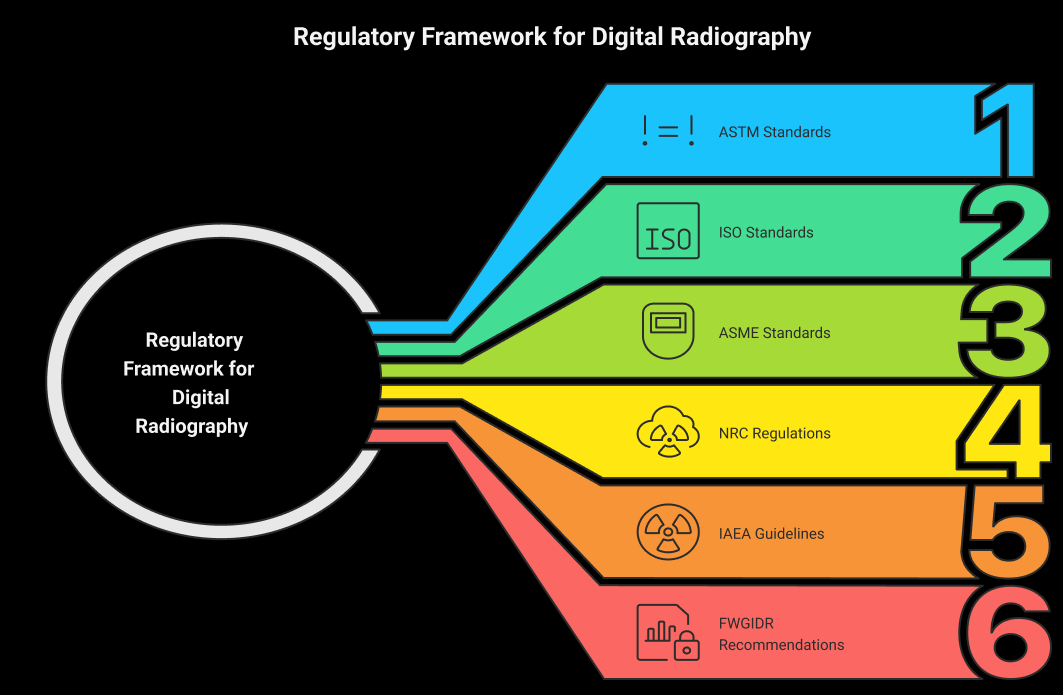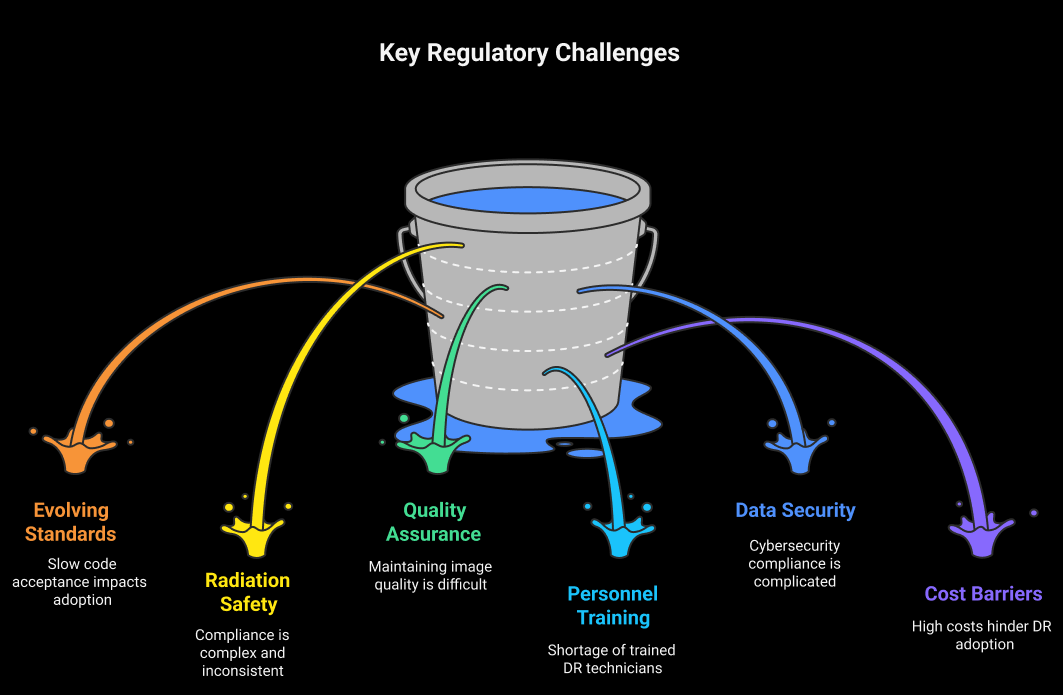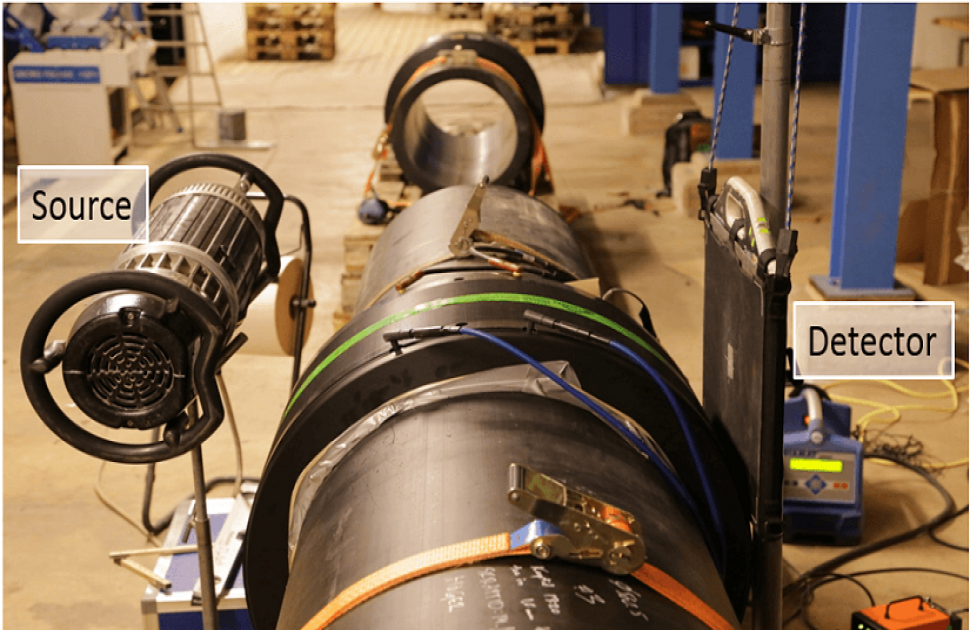Table Of Contents
- The Regulatory Framework for Digital Radiography
- Key Regulatory Challenges
- Strategies for Overcoming Challenges
- Conclusion
- FAQs:
Digital Radiography (DR) is a new radiographic test method, which involves the use of digital detectors such as flat-panel detectors ( FPDs ) or computed radiography plates to store and transform the X-ray or gamma-ray energy into high-resolution digital images. In comparison to the traditional film-based radiography, DR has instant image acquisition, higher contrast sensitivity, and higher radiation dose efficiency. It does not require chemical processing to undertake image processing; this allows the assessment of images faster, characterizes defects better and simplifies data storage and sharing. The benefits have seen digital radiography become one of the most important changes in Non-Destructive Testing (NDT), which has changed the inspection processes in the field of aerospace, oil and gas, nuclear, manufacturing, etc.
Nevertheless, as much as its technical superiority has been proven, the widespread use of DR in NDT has significant regulatory hurdles. The shift of traditional to the digital systems has been faster than the international standards and codes and thus, there are inconsistencies in the qualification, data management and radiation safety requirements. Although standards such as ASME BPVC Section V and the ISO standards are not comprehensive guidelines, international differences in the digital radiography regulation standards, compliance documentation, and equipment qualification have created viable obstacles to implementation and certification.
By means of this article, a reader will have a clear insight into the most critical regulatory and technical issues related to the implementation of digital radiography in NDT. It will delve into the impacts of changing standards, radiation safety measures, data privacy and staffing qualification on the implementation of DR in the industries. It will also talk about ways to counter these challenges including aligning codes, improving training and taking advantage of new technologies so that DR not only passes the compliance test but also reaches its full potential as a safe, reliable and internationally accepted method of NDT.
The Regulatory Framework for Digital Radiography
The use of DR in NDT is regulated by a complicated mixture of standards that are issued by organizations including the American Society of Testing and Materials (ASTM), the American Society of Mechanical Engineers (ASME), the International Organization of Standardization (ISO), and European Norms (EN). The ASTM standards cover the performance of equipment, data format and qualifications of detectors to obtain the performance of DR systems approaching that of film radiography in terms of reliability. The ISO, especially ISO standards on welded piping inspection, include the requirements concerning the image quality indicators (IQIs) or the images collected by the equipment used to comply with the assessment of each type of defect detection capacity.
The ASME digital radiography code, integrated into the Boiler and Pressure Vessel Code (BPVC) Section V, Article 2, provides detailed protocols through Mandatory Appendices VIII (computed radiography) and IX (direct DR). These appendixes specify requirements of weld inspections on pressurized components, including such metrics as normalized signal-to-noise ratio (nSNR), basic spatial resolution (SR b), and contrast sensitivity. The Nuclear Regulatory Commission (NRC) of the U.S government regulates application of nuclear activities, whereas the International Atomic Energy Agency (IAEA) facilitates the world protection and education of radiations. The working group on Industrial Digital Radiography at the Federal government (FWGIDR) recommends data standards such as the DICONDE to provide a secure and standard data processing. Such diffuse regulatory context provides hurdles in standardising DR practices on regional and industry level, making adoption difficult.

Key Regulatory Challenges
1. Evolving Standards and Code Acceptance
Regulatory standards adoption is a core hurdle to DR adoption due to its sluggish development. Many codes, developed originally to apply to the use of film in radiography, do not address DR as fully as they apply to these applications, thus curtailing the use of DR in more critical applications e.g. specific types of welds or in high pressure vessels. Although these standards (ASME, ASTM) allow DR to be used today when dealing with pipes, plates, and castings, and in fact include corrosion assessment, its use is forbidden in some industries because it has not been proved to be equivalent to the conventional inspection methods in any other respect. These differences in requirements, e.g. IQI visibility, nSNR thresholds, make compliance a difficult issue, with digital systems varying from vendor to vendor. Code update lags the rapid technological changes in the DR causing NDT providers to sail on un-updated or inconsistent standards. Such regulatory lag makes things costly and unnecessarily late in uptake of the same, especially in the industry that has strict safety standards.
2. DR Radiation Safety Compliance
Radiation safety is a cornerstone of radiographic testing, and DR’s ability to reduce radiation doses through higher detector sensitivity and fewer retakes is a key advantage. Nevertheless, the question of adherence to such bodies as the NRC and IAEA is complicated. Digital detectors are sensitive to overexposure that might result in damages on equipment and force the need of further exposure, and therefore, to potential risks during working. Laws require stringent shielding, and employee dosimetry and contingencies specific to DR systems. Such global standards are not always consistent, e.g. the U.S. Title 10 CFR Part 34 emphasis on sealed source licensing will have to be applied in conjunction with the more general IAEA risk-based guidelines, complicating compliance by multinational organizations with U.S. standards. In areas of confined space such as a pipeline, radiation exposures will be geo-tagged, creating additional burdens of regulation, which demand accurate detailed documentation to address jurisdictional issues.
3. Digital RT Quality Assurance
The high-quality requirement in digital RT is superior to guaranteeing accurate checking of defects, e.g., cracking lines or inclusion in welds. The parameters to be satisfied with code thresholds include modulation transfer function (MTF), limiting spatial resolution (LSR) and SR_b that must be calibrated accordingly. Nevertheless, there is a difficulty of attaining the same image quality in DR due to a reduced native contrast compared to film. Post processing such as high-pass filtering and subsequent multi-gain calibration increase defect visibility, although it is possible to add artifacts that do not conform to regulations. In nuclear, such demonstrations of compliance with performance are required to ensure accuracy of flaw sizing, but the absence of standardized datasets are an obstacle to demonstration. Information integrity, which has been subjected to DICONDE, must be supported by high-performance systems, to avoid the possibility of tampering, a point that presents difficulties in terms of financial resources, in addition to the process of adoption.
4. Personnel Training and Certification
A specification training is needed to make a transition to DR because film radiography techniques do not completely apply to a digital environment. Certification agencies require additional certification to Levels I, II and III personnel, including software operation, image interpretation and artifact recognition. Curricula to such certifications provided by IAEA are available, but there is a shortage of experienced DR technicians, especially in the developing world, which is holding up adoption. The requirement in ASME to use practical demonstrations in certification brings administrative requirements, provided there should be frequent re-certification and tests. The skills gap requires committing a lot on the training programs, and this may be overwhelming to NDT providers, particularly the smaller ones.
5. Data Security and Cybersecurity Compliance
The virtuality of DR presents some peculiar regulatory issues in terms of data security and cybersecurity. As opposed to film, DR images are electronically stored and transmitted, which poses a lot of risks as it can be easily hacked or manipulated. The regulatory environments, especially those that are EN standards in Europe, are increasingly focusing on cybersecurity requirements to facilitate inspection sensitive information. Compliance will require adoption of encryption, access control and secure data transfer protocols that meet some standards such as DICONDE. But hooking these measures into established NDT processes is a complicated process, particularly to organizations that have legacy systems. There are also regulatory differences by region, e.g. the high data protection regulations in Europe compared to less prescriptive regulations in the emerging markets, which necessitates specific cybersecurity approaches when an additional legal burden is added to the cost of operation.
6. Cost and Infrastructure Barriers
The cost of migration to DR is expensive and it is a governance and practical issue. DR systems face an investment process that involves substantial cost to upgrade digital detectors, software, and other digital technologies to be able to comply with quality assurance and data management regulations. The financial constraints that small and medium-sized NDT providers, especially in the developing regions, with regard to adoption of compliant systems. The regulatory necessities to perform systematic system-calibration, performance checks, and train personnel add even further to cost. Moreover, there are infrastructure constraints like unreliable electricity supply or poor internet connectivity in distant locations which make it hard to comply with digital requirements like real-time data archiving. Such barriers tend to disadvantage unrewarded companies, whose approach to DR adoption can as a result be postponed even though long-term advantages are eminent.

Strategies for Overcoming Challenges
1. Harmonizing Standards
Collaboration through bodies like FWGIDR can streamline digital radiography regulation standards, promoting tools for system qualification and DICONDE adoption. Participation in ASTM, ASME and ISO to revise such codes as the ASME BPVC would capture the advancements in DR will narrow the gaps in compliance. The stakeholders in the industry need to campaign on the adoption of performance-based standards that would coincide with technological changes but also remain reliable.
2. Enhancing Radiation Safety Protocols
Investing in DR-specific safety training and automated exposure monitoring systems can ensure DR radiation safety compliance while maximizing dose reduction benefits. The creation of global safety standards regardless of nationality will ease the compliance of multinational operations in accordance with IAEA standards. Geo-tagging solutions of confined-space inspection may be effectively used to accommodate jurisdictional needs.
3. Strengthening Quality Assurance
Developing standardized datasets for DR validation and integrating AI for image analysis—while ensuring regulatory approval as software-based devices—can enhance digital RT quality assurance. Recurring system calibration, IQI testing and compliance to DICONDE standards will bring DR in line with the code. Work with international working groups to provide benchmarking standards in the detection of flaws will aid the regulatory acceptance.
3. Building a Skilled Workforce
The long-term effect of a shortage of qualified DR technicians can be solved with the amalgamation of stages with ASTM, IAEA, and industry training providers. Efficient certification procedures, such as electronic learning paths and other practical lab courses, will be used to meet the increasing need of skills. By offering incentives to recertify by offering professional development programs, burdens minus administration as an action may be mitigated.
2. Leveraging Industry Collaboration
Firm-wide cooperation is required in counteracting regulation. To enable sharing of resources, joint validation studies and lobbying of regulatory updates, NDT organizations can create consortia. The best practices on system qualification and data management can be standardized in collaborative platforms like that created by FWGIDR. Complying with the evolving requirements in the codes by interacting with equipment vendors will also ease the compliance with DR systems.
3. Adopting Emerging Technologies
New technology, such as artificial intelligence and machine learning, may also improve the usage of DR since it is possible to implement quality assurance and defect detection as automated processes with regard to the regulatory aspects. Clouds can provide a secure data storage and real-time analysis platform, eliminating cybersecurity implications, as well as increasing accessibility, even in remote places. Regulatory agencies must also be brought onboard at the early stages to make sure that such technologies match with the available codes so that they can easily adapt them in NDT processes.

Conclusion
Multifaceted regulatory issues such as radiation safety compliance, requirements of quality assurance, the changing standards, personnel training, and data security as well as high costs make adoption of digital radiography in non-destructive testing to be a hindering factor. While frameworks like the ASME digital radiography code provide critical guidance, gaps in harmonization and acceptance persist across regions and industries. To a researcher and individual working in the field of NDT, these obstacles have to be overcome by actively seeking out the regulatory bodies, training and infrastructure investments, and new technologies. By addressing these challenges collaboratively, the NDT community can fully harness DR’s potential, enhancing safety, efficiency, and reliability in radiographic testing.
FAQs:
1. What is DRT in NDT?
Digital radiography (DRT) is a sophisticated nondestructive testing (NDT) method that creates digital images for analysis by using X-ray or gamma-ray radiation to examine internal structures or objects. In order to determine the remaining wall thickness, DRT is frequently used to measure the thickness of pipes and spools.
2. What is the maximum thickness for RT?
In many instances, operational industrial installations can also be inspected using RT. Materials with thicknesses between 10 and 120 millimeters can be tested with gamma rays, while materials with a maximum thickness of 50 millimeters can be tested with X-rays.
3. What are the challenges of radiography?
Despite their critical role in healthcare, radiographers confront a number of occupational health issues, such as burnout, exhaustion, sleep difficulties, and work-related musculoskeletal disorders (WRMSDs).
4. What is IQI in radiography?
A penetrameter, sometimes referred to as a picture Quality Indicator (IQI), is a tool used in radiography to evaluate the sensitivity and quality of a picture. In essence, it serves as a guide to make sure the radiography method can identify defects or discontinuities in the material under examination that are a specific size.
5. What is the full form of TFT in radiography?
An array of thin-film transistors (TFTs) reads data from an indirect flat panel, which is the most popular kind of digital radiography system. The fundamental technology used to operate LCDs (Liquid Crystal Displays) in many popular flat panel TVs and monitors is also used by TFT flat panels.










